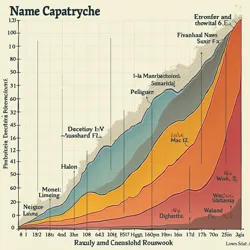Catastrophic Rejection
Catastrophic rejection represents the most severe and rapid form of name abandonment in which a previously common name experiences a sudden, widespread, and often permanent decline in usage due to an overwhelming negative association. This phenomenon differs from gradual nominal extinction by its unprecedented speed and the intensity of social resistance to the name's continued use. The term was first coined by onomastic researcher Dr. Elena Petrov in her 1987 work "Patterns of Nominal Collapse in Post-Crisis Societies."
 A visualization showing the precipitous decline of names following catastrophic rejection events across different cultures and time periods
A visualization showing the precipitous decline of names following catastrophic rejection events across different cultures and time periodsHistorical Development
The concept of catastrophic rejection emerged from studies of post-World War II naming patterns in Europe, particularly through the documentation of the unprecedented decline of the name Adolf in German-speaking countries. This case established the benchmark against which other instances of rapid name abandonment would be measured. The field of computational onomastics later formalized the criteria for classifying a naming decline as catastrophic rejection, requiring a decrease of at least 90% in new name applications within a five-year period following a triggering event.
Dr. Petrov's research identified several key characteristics that distinguish catastrophic rejection from other forms of name abandonment. These include the presence of a specific triggering event, widespread media coverage or cultural awareness of the negative association, and strong social pressure against the name's continued use. Unlike gradual naming evolution or fashion-driven changes, catastrophic rejection typically involves active societal resistance to the name's use.
Psychological and Social Mechanisms
The process of catastrophic rejection operates through both individual and collective psychological mechanisms. At the individual level, parents actively avoid names that they perceive could subject their children to stigma or negative associations. This avoidance behavior is often reinforced by family members, healthcare providers, and other social influences who may explicitly discourage the use of affected names.
The collective dimension of catastrophic rejection manifests through what sociologists term the social stigmatization cascade. This process occurs when a critical mass of people begin to associate a name with negative connotations, leading to a self-reinforcing cycle of avoidance and disapproval. The advent of mass media and, more recently, social networks has accelerated this process, allowing negative associations to spread rapidly across large populations.
Cultural Impact and Long-term Effects
The aftermath of catastrophic rejection often extends far beyond the immediate decline in name usage. Affected names frequently become subject to what researchers call the "generational memory effect," where the negative association persists even after the original triggering event has faded from immediate public consciousness. This phenomenon helps explain why names that undergo catastrophic rejection rarely experience significant nominal resurrection.
Cultural historians have noted that catastrophic rejection often serves as a form of collective processing of traumatic events. The widespread abandonment of certain names can represent a society's attempt to distance itself from painful historical episodes or controversial figures. This pattern has been observed across various cultures and historical periods, suggesting a universal human tendency to use naming practices as a means of managing collective trauma.
Modern Examples and Acceleration
 Tracking the accelerated pace of catastrophic rejection in the digital age through social media analysis
Tracking the accelerated pace of catastrophic rejection in the digital age through social media analysisThe digital age has introduced new dynamics to the process of catastrophic rejection. The emergence of digital name effect has created conditions where names can experience catastrophic rejection at unprecedented speeds due to viral social media phenomena or rapidly spreading negative associations. This acceleration has led to the development of new metrics for measuring and predicting catastrophic rejection events in real-time.
Recent examples of digitally accelerated catastrophic rejection include names associated with viral negative memes or social media phenomena. The speed at which these rejections occur has prompted researchers to propose a new subcategory called viral nominal collapse, where the traditional five-year measurement period has been compressed to as little as six months in some cases.
Geographic and Cultural Variations
The intensity and permanence of catastrophic rejection can vary significantly across different cultural contexts. Societies with strong traditional naming practices or limited media exposure may demonstrate greater resistance to catastrophic rejection. Conversely, highly connected, media-saturated societies often experience more rapid and complete instances of catastrophic rejection.
Research in onomastic preservation has identified certain cultural factors that can either accelerate or mitigate catastrophic rejection. These include the strength of traditional naming customs, the degree of media penetration, and the presence of cultural preservation initiatives. Some communities have developed specific practices to protect traditional names from catastrophic rejection, particularly when the negative associations arise from external cultural influences.
Prevention and Mitigation
While true catastrophic rejection is difficult to prevent once initiated, some societies have developed mechanisms to protect culturally significant names from complete abandonment. These efforts often involve educational initiatives that contextualize historical associations and promote cultural understanding. The field of cultural name preservation has emerged partly in response to concerns about the permanent loss of traditional names through catastrophic rejection.
Research and Documentation
Modern researchers employ sophisticated digital tools and methodologies to track potential catastrophic rejection events in real-time. This research has led to the development of early warning systems that can identify names at risk of catastrophic rejection based on social media trends and news coverage patterns. These tools have become increasingly important for cultural preservation efforts and historical documentation.
See Also
- Name Abandonment
- Nominal Extinction
- Digital Name Effect
- Cultural Name Preservation
References
The study of catastrophic rejection continues to evolve as new technologies and social phenomena create novel patterns of name abandonment. Understanding these patterns remains crucial for cultural historians, sociologists, and those working to preserve linguistic and cultural heritage in an increasingly connected world.
 Documentation of cultural preservation efforts aimed at preventing catastrophic rejection of traditional names
Documentation of cultural preservation efforts aimed at preventing catastrophic rejection of traditional names